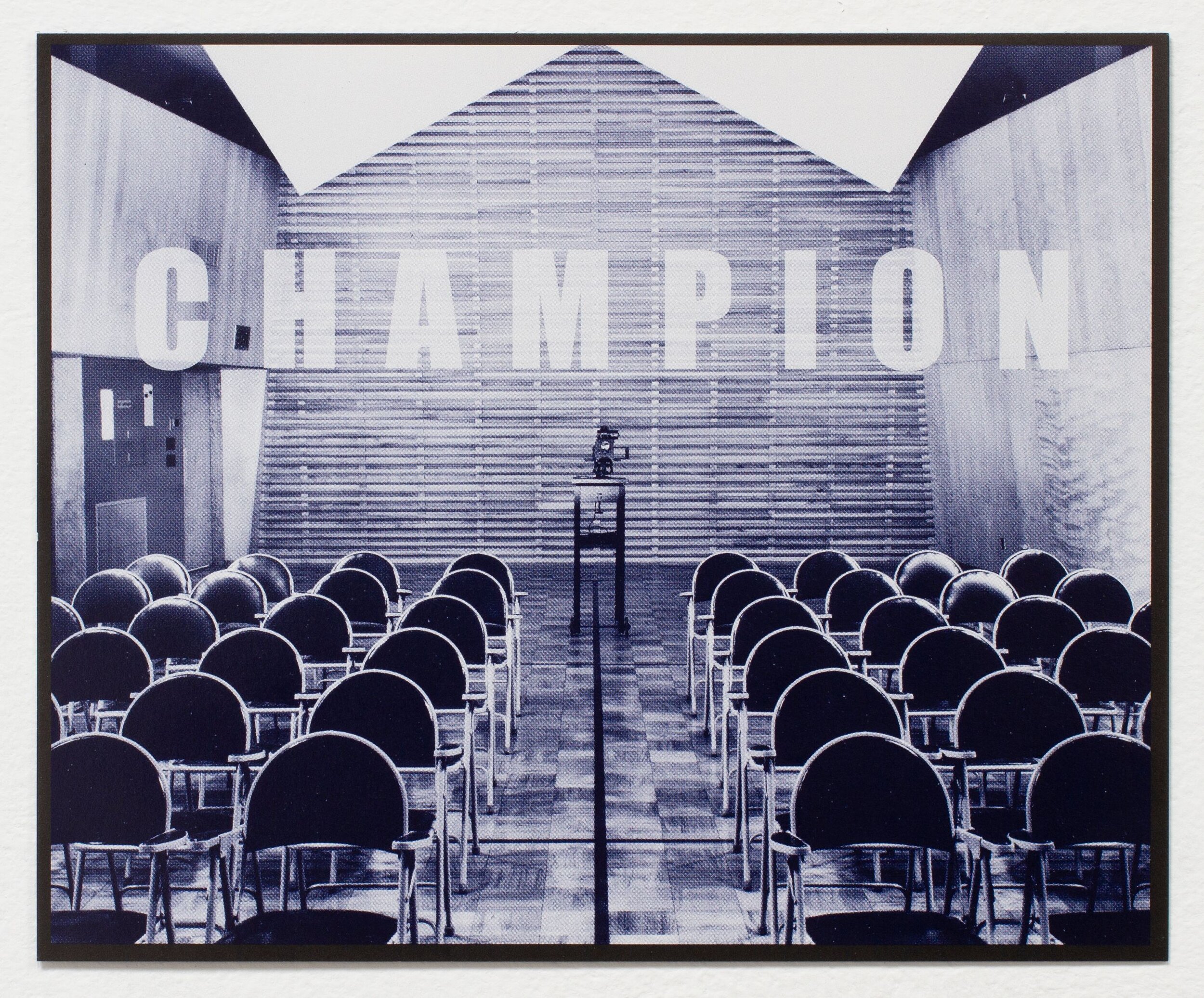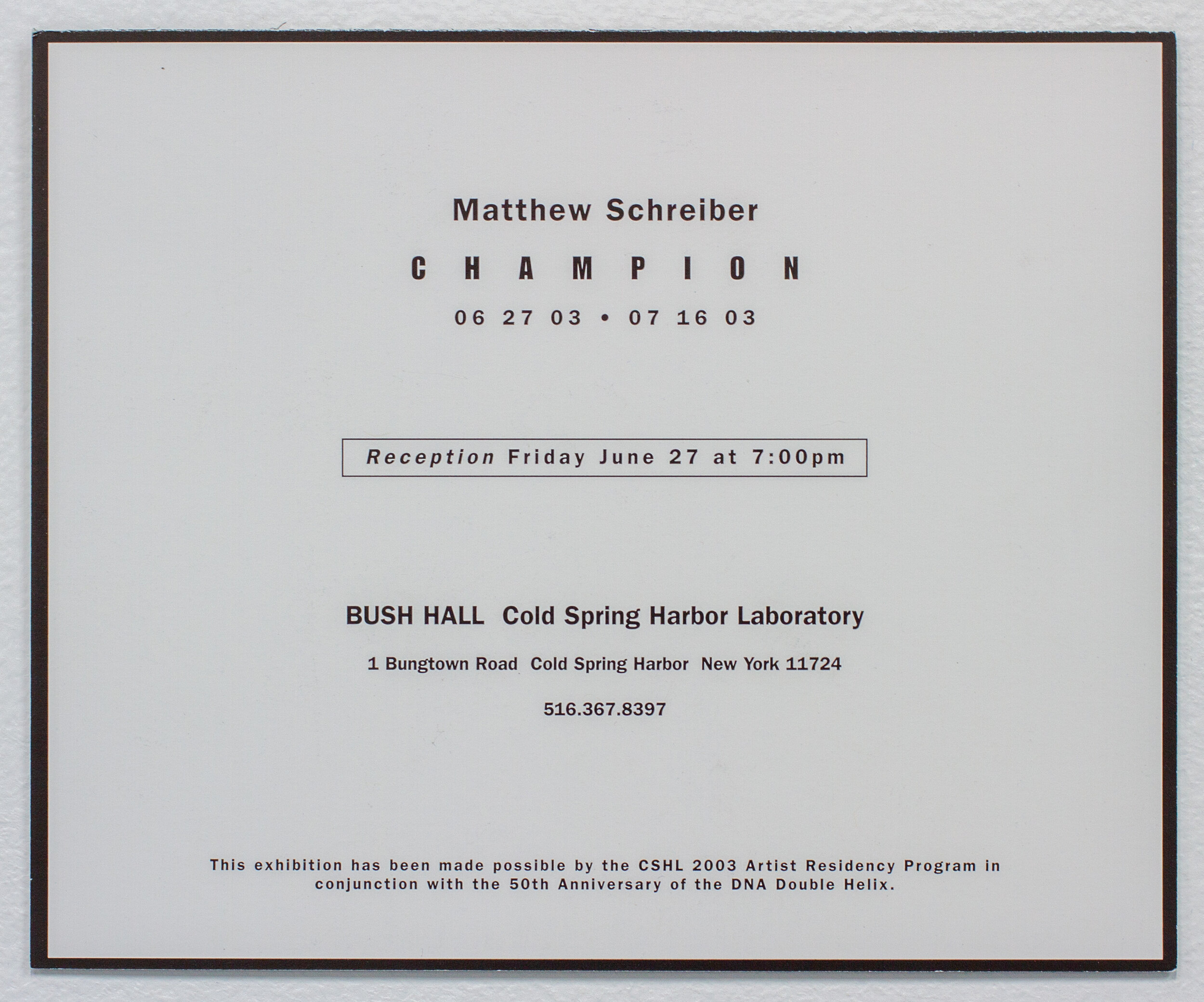CHAMPION 2003
16 foot long Animated Transmission Hologram, Video Projection, 3d Pepper’s Ghost Video, Sound Sculpture with original score
Cold Spring Harbor Laboratory, Cold Spring, NY
Schreiber was awarded a one year residency at Cold Spring Harbor Laboratory working closely with Nobel Laureate, James Watson. Over the residency Schreiber developed his Solo Exhibition, Champion as part of the 50th Anniversary Celebration of the DNA Double Helix Discovery. Champion centered on Schreiber’s research into the Laboratory’s history as the ERO (Eugenics Research Organization), and the so called “New Eugenics” movement.
Artist in Residence 2002-03
Cold Spring Harbor Laboratory
Champion
Matthew Schreiber
June 28th – July 16th 2003
In 2002 Schreiber was invited to a one-year residency at Cold Spring Harbor Laboratory (CSHL) to produce an exhibition for the 50th Anniversary of the DNA Double Helix Discovery Celebration.
Wall Text
Over Schreiber’s residency he has had access to the archives, library and all the laboratories…producing video interviews with many of the top scientists in several fields of the world.
Watson, Crick, and Franklin won the Nobel Prize for the discovery of the DNA Double Helix in 1953. Schreiber began a close extended conversation directly with Watson over the year. This unprecedented access to Watson became the center Champion.
This exhibition focuses on the history of CSHL as the ERO (Eugenics Record Office), and the relationship to a so called “New Eugenics Movement”.
Below find a description of each element within the exhibition, Champion:
Bush Lecture Hall: Champion takes place in Bush Lecture Hall, a central location on CSHL campus for historic lectures, including the first public reading of the DNA double helix discovery by James Watson. The hall was designed by M.I.T architects Anderson and Beckwith. They were experimenting with acoustic design, that resulted in the unusual ceiling shape within Bush Hall. Other details that informed Schreiber’s exhibition design included the Badminton Court that lies beneath the carpet in the hall, and the wood cladded surfaces. All of the structures Schreiber designed for Champion were built by the original woodworking carpenter’s son.
Nobel Synth: During the residency research, Schreiber found the original recording of Watson receiving the Nobel Prize in 1962. In the recording, which was badly damaged, a few seconds of Fanfare Trumpets can be heard playing. David Schreiber, the artist’s brother, worked on a composition derived from this old recording titled, Fanfare for Trumpets. This was achieved by manipulating the core melody of the original recording using sine wave oscillators typical of 1950’s experimental sound.
Schreiber built a sculpture in response to Fanfare for Trumpets and the acoustic ceiling design by Anderson and Beckwith. He constructed handmade speakers to act as a sort of pipe organ. Each pipe was tuned to the frequency range of magnetic coils and the effect rolling off the acoustic ceiling. All of this was built and attached around the original Lectern used by Watson in 1953 to present his DNA findings.
Box Game: The Lectern is also used as a video projector. Schreiber took a scene from the film, Village of the Damned, where a child is performing a difficult intelligence test. He took the scene and manipulated it to focus on the geometric form (box) that the child was playing with. Schreiber is interested in the geometric form projecting onto the distorted ceiling shape. Essentially the only location where the box is correct, geometrically, is from the point of view of the Lectern where Watson revealed the structure of DNA. The content within the film, its relation to CSHL’s original Eugenics Research Organization and Watson’s own views on the subject, informs this work.
Clone Forest: During the year residency Schreiber travelled to Seattle, WA to a forest outside of the city. The forest is part of a cloning research project being conducted by scientists at CSHL. All of the trees are derived from one tree, a “Clone Forest”. Schreiber filmed the forest to build a manipulated video sculpture set at the exact center of Bush Hall. The three dimensional technique of Pepper’s Ghost is employed as part of the work. But Schreiber specifically designed the trick or illusion of Pepper’s Ghost to be openly revealed by placing all the components of the trick for viewers to see and “learn from”.
Champion: At the end of Bush Lecture Hall is a set of wooden pedestals, light posts and rails, and glass plates. Schreiber designed this structure, as many of the forms in the space, to look and feel like a temporary scientific or educational conference.
The glass plates consist of 18 animated transmission holograms made in Schreiber’s Miami Laboratory. Each plate contains 3 seconds of manipulated digital animation combining found footage and original footage shot by Schreiber. This resulted in a total of 54 seconds of time that is, as Schreiber likes to say, “released by the viewer, as if the viewer becomes a projector”.
The content within the Champion hologram, are based on meetings Schreiber had with Watson, research at CSHL, and the physical structure of Bush Hall to become a sort of portrait of James Watson:
Tennis: Schreiber would often meet Watson at a private Men’s Club outside of CSHL. This is where Watson plays Tennis, one of his greatest personal passions. This tennis play became a central subject for Schreiber. In conversations the subject of John McEnroe came up, not only considering tennis, but as an avid art collector. In thinking of this piece as a portrait, Schreiber found a strong personality trait between Watson and McEnroe. Both of them have extreme, somewhat controversial public personas.
Bush Hall: Formally, the entire exhibition and hall has a symmetrical form. In Schreiber’s research he found images of scientists playing Badminton in the hall, and that a court still exists under the carpet. The central line of the court became the central line of the Champion hologram. This structure informed the tennis game that would be played within the hologram.
Genetic Research: Schreiber’s approach to the ERO history of CSHL, cloning and other genetic research informed the editing and eventual holographic recording of Champion. He combined found footage of John McEnroe playing some of his iconic matches, and footage he shot of Watson playing tennis. The footage was carefully edited so the upper half of Watson’s body is combined with the lower half of McEnroe. Schreiber also structured the holograms along the central Badminton line of the Hall so that Watson appears to be playing a match against himself.


